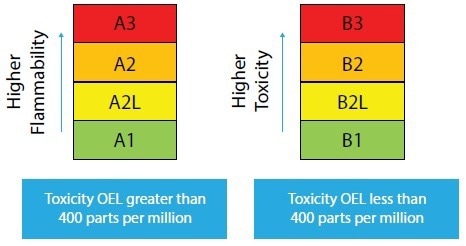The quest for enhanced fuel and energy efficiency, coupled with a desire to curb the impacts of global warming, has been a persistent trend across numerous industries worldwide. The heating, ventilation, and air conditioning sector has emerged as a critical focus among these industries.
According to the U.S. Energy Information Administration, cooling residential and commercial buildings consumes 10 percent of total electricity usage.
In response, the industry has embraced a new trend of adopting A2L HVAC systems that employ innovative refrigerant types. These refrigerants are designed to be highly energy efficient and environmentally friendly, reducing greenhouse gas emissions.
The shift towards using advanced A2L refrigerants is expected to reduce the carbon footprint of HVAC systems further, promoting a healthier world.
Push for A2L - Regulatory and Historical Background
The development of A2L refrigerants can be traced back to the late 1970s and early to mid-1980s when scientists discovered man-made chlorofluorocarbons (CFCs) and hydrochlorofluorocarbons (HCFCs) were causing the thinning of the ozone layer in the Earth's atmosphere.
These discoveries led to the creation of the Montreal Protocol, which all 198 UN Member States adopted in September 1987. To this day, it is the only treaty ratified by every country on Earth.

Image Credit: Sensata Technologies, Inc.
The treaty established a phase-down schedule for nearly 100 man-made chemicals designated as ozone-depleting substances, many traditionally used in refrigeration and air conditioning.
Under that schedule, developed countries completed the phased-out HCFCs by 2020, with developing countries following by 2030. Hydrofluorocarbons (HFCs) were introduced to replace these ozone-depleting chemicals.
While they did not have the same negative impact on the ozone layer, these chemicals still elevated the global warming potential (GWP), which increased their impact on global warming.
To address this issue, the United Nations developed the Kigali Amendment in 2016, which aims to phase out HFCs over time and reduce their use by 80 to 85 percent by the late 2040s in developed countries.
Many European countries have taken independent actions, and the United States ratified the agreement in September 2022. Throughout the past 40+ years, refrigerant technology has increasingly moved towards systems with a reduced GWP and lower environmental impact.
Breaking Down Environmental Impact of Refrigerants
The significance of the A2L category concerning the environmental impact of refrigerants is rooted in the comprehensive influence of these chemicals on the environment. Typically, chemicals are categorized based on their flammability and toxicity following ISO 817.
Chemicals classified as A3 are considered less toxic but highly flammable, while B1 chemicals are non-flammable but toxic. On the other hand, A2L chemicals have lower toxicity levels and are slightly flammable.
The efficiency and effectiveness of a chemical for a particular purpose is the third consideration. The central portion of the environmental impact of HVAC equipment, around 70 percent, arises from their power consumption and the associated energy generation procedures.
The ultimate goal is to balance a chemical's GWP and its efficiency in HVAC use while also considering flammability, toxicity, and other factors.
Although legacy hydrofluorocarbons provided strong efficiency in HVAC systems, they had high GWP rates and ozone depletion issues. In contrast, many A2L refrigerants developed in recent years deliver better HVAC performance without these negative side effects.
Despite using other chemicals such as CO2, propane, or ammonia in HVAC systems, each presents a unique issue that impedes widespread use. CO2 systems require higher pressure levels than other systems, propane is highly flammable, and ammonia can potentially be extremely toxic.

Image Credit: Sensata Technologies, Inc.
Table 1. Source: Sensata Technologies, Inc.
| |
R12 Freon
(Banned CFC) |
HFC-134a |
HFC-152a |
CO2
(R-744) |
Propane
(R290) |
Ammonia |
| Ozone Depletion Potential (ODP) |
1 |
0 |
0 |
0 |
0 |
0 |
| Global Warming Potential (GWP) |
10,200 |
1,430 |
124 |
1 |
3 |
0 |
| Flammability / Toxicity |
A1 |
A2L |
A2L |
A1 |
A3 |
B2L |
| Operating Pressure Range |
2.1 - 11.7 bar |
0.6 - 6.7 bar |
0.6 - 6.7 bar |
10 -150 bar |
10 - 50 bar |
2.9 -13.5 bar |
Therefore, the A2L category balances GWP, safety, and cooling efficiency in HVAC contexts.
Codifying A2L HVAC Systems in Buildings
A2L systems have already been used in several countries, including the European Union, Japan, India, Australia, and the automotive industry.
As the benefits of A2L systems have become more apparent, regulatory bodies have adapted their regulations to account for their use in commercial and residential HVAC systems, such as ASHRAE 15-2019 and UL 60335-2-40.
To ignite, A2L gases would need to leak, reach concentrations above the chemical's lower flammability limit, and then be exposed to an open flame or other ignition source. To prevent this, much regulatory attention has been focused on preventing and detecting leaks within a given system.
HVAC systems designed to operate with A2L refrigerants must be designed to be inoperable if leak detection systems are bypassed.
These leak detection systems must withstand harsh environmental conditions, including high condensation and significant temperature extremes, without requiring additional maintenance or calibration over a planned 15-year equipment lifespan.
Using oils or other chemicals in servicing HVAC equipment may foul some detection systems, adding pressure on HVAC OEMs and their partners to develop solutions for the next generation of equipment.
Looking Forward with Refrigerant Technology
Over the past four decades, the trajectory of HVAC technologies has been aimed toward greener solutions and refrigerants. This trend is expected to persist in the future.
To that end, the Kigali Amendment has been introduced to curb the use of HFCs, a move projected to avert over 100 million tons of carbon dioxide equivalent emissions.
With the success of this effort, it is hoped that by 2100, global temperatures will not have risen by up to half a degree Celsius. In the future, advancements in HVAC system design will continue to prioritize safety, environmental impact, and energy efficiency worldwide.

This information has been sourced, reviewed and adapted from materials provided by Sensata Technologies, Inc.
For more information on this source, please visit Sensata Technologies, Inc.